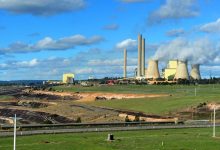AGL Energy has conceded its controversial demerger plans are not consistent with Paris climate goals, despite a majority of shareholders indicating last year they would supporting a demerger only if it met climate targets.
The company’s scheme of arrangement – a 350 plus page document outlining the details of the proposed company split – appears to support many of the arguments pushed by tech billionaire Mike Cannon-Brookes, who is fiercely opposing the demerger.
The centrepiece of the strategy for the newly formed Accel Energy, which will operate the remaining coal generators, is to keep the Bayswater coal generator in NSW running until 2033, and the Loy Yang A brown coal generator as late as 2045.
“These commitments are not aligned to the goals of the Paris Agreement as at the date of this Scheme Booklet,” says AGL, which is Australia’s biggest polluter courtesy of those coal generators.
“However, they strike a balance between Australia’s current and future energy needs and the requirements to decarbonise without significantly impacting energy system reliability or affordability or shareholder value.”
This is the heart of the dispute between AGL and Cannon-Brookes, who last week spent $660 million snapping up a 11.3 per cent stake that could stop AGL get majority shareholder approval for the move.
Cannon-Brookes argues that the last unit of the remaining coal generators should be closed by 2035 at the latest, to be consistent with the Paris targets and to give it a chance of seizing the opportunities ahead of it.
He is also critical of AGL’s target of 2.7GW of new renewables and storage investment by Accel by 2030, saying it is too slow. That view is echoed by environmental groups.
“It is simply not moving quick enough,” says Dan Gocher, the director of Climate & Environment at the Australasian Centre for Corporate Responsibility.
“Alignment with the Paris Agreement across both demerged entities was a fundamental demand of a majority of AGL’s shareholders less than a year ago. (When 53 per cent voted in support of a demerger that was “consistent” with the Paris target).
“We don’t expect AGL’s largest shareholders will take well to being ignored. According to the IEA and the IPCC, alignment with the Paris Agreement means closing coal-fired power stations in OECD countries by 2030.”
It should also be noted that the Australian Energy Market Operator’s planning blueprint assumes all brown coal generators will be closed within a decade, with system reliability maintained, and that is a view endorsed by the overwhelming majority of energy experts.
AGL’s scheme booklet also appears to support more of Cannon-Brooke’s complaints about the demerger – namely that the split entities may not be worth as much as they would together, would have fewer funding options, and will lose other benefits of working together.
Indeed, as is usual in such deals, the only easily defined winners of the de-merger so far is the bevy of lawyers, bankers and other advisors, who will share in a windfall $260 million from the costs of the demerger.
According to the AGL booklet, around $160 million of these costs are locked in anyway, meaning they will be incurred whether or not the scheme is approved by shareholders on June 15.
Advisory costs of $75 million include fees paid to financial advisors, independent board advice, and legal, tax, accounting, human resources and strategy costs.
Another $185 million of restructuring costs include a range of activities associated with restructuring and separating the companies, and establishing the new debt facilities (banking fees).
The document also notes that the demerger will increase net tax inefficiencies with a net present value of approximately $125 million, and will require $200 million of extra working capital, mostly to manage margin calls associated with energy trading activities.
It will also result in net additional corporate and operating costs of approximately $35 million per year, and add around 1.25 per cent and 1.40 per cent to its debt margins.
AGL’s list of advantages are not huge. It focuses mostly on creating a “cleanskin” company in the form of AGL Australia, which will be freed of the coal assets and able to pursue green solutions for its customers, and to offer its shareholders choice.
But this is exactly the problem that Cannon-Brookes has highlighted – in effect jettisoning the coal assets into a company with no credible climate target, and with less resources to negotiate the transition.
And energy market observers – at least those keen to reach zero emissions (which is most of them) – are horrified.
“Loy Yang has a carbon intensity of 1.3 (!!!!!!!!!!!!!!!!!!!!!!!) tco2-e/mwh,” independent analyst Ketan Joshi (also a contributor to RenewEconomy) tweeted.
“This is the plant they’re wanting to run until 2045. Their worst power plant for another 23 years. I am not being hyperbolic when I say that this really is madness.”
See also: Win or lose, Cannon-Brookes is forcing coal die-hards to face the future
And: “Coal fired power stations will close, regardless of who’s in office”; says Bowen










